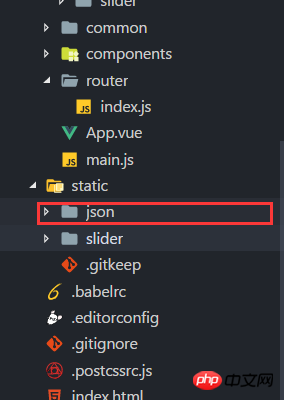
This time I will bring you how vue:srcprocesses filesPath error, vue:src handles file path errorsWhat are the precautions, the following is a practical case, let’s take a look take a look.
Assets: During the project compilation process, they will be processed and parsed into module dependencies by webpack. Only relative paths are supported, such as < img src=”./logo.png”>And <code><a href="http://www.php.cn/wiki/892.html" target="_blank">background</a>:url(./logo.png), "./logo.png" is a relative resource path, which will be resolved by webpack as a module dependency
static: in Files in this directory will not be processed by webpack. Simply speaking, the place where third-party files are stored will not be parsed by webpack. It will be copied directly to the final packaging directory (default is dist/static). These files must be referenced using absolute paths, which are determined through the build.assetsPublic and build.assertsSubDirectory links in the config.js file. Any file placed in static/ needs to be referenced in the form of an absolute path: /static[filename]
According to the characteristics of webpack, in general, static files will not change. Files in the third file may be asserted. Changed files
The problem is here. Use js to dynamically load assets or pictures of this file and a 404 status code
code example
<li v-for="(item,index) in images" :key="index">
<img :src="item.src"></li>
//js部分
data(){
return {
images:[{src:'./1.png'},{./2.png}]
}
}When I ran it, I found that the image was not displayed, and the error code was 404,
Reason: In webpack, images are used as modules because they are dynamically loaded. Therefore, url-loader will not be able to parse the image address, and then the path will not be processed after npm run dev or npm run build [The path parsed by webpack will be parsed as /static/img/[filename].png, the complete address is localhost:8080/static/img/[filename].png】
Solution:
①Load the image as a module, such as images:[{src:<a href="http://www.php.cn/wiki/136.html" target="_blank">require</a>('./1.png')},{src:require('./2.png' )}]So webpack can parse it.
②Put the image in the static directory, but it must be written as an absolute path, such as images:[{src:”/static/1.png”},{src:”/static/2.png ”}]The picture will also be displayed. Of course, you can also shorten the writing length of the path by defining it in webpack.base.config.js.
Of course you said that when there are too many local pictures, it would be troublesome to write like this. Well, in fact, we simplify the operation like this.
Step one: Create a new json folder in static

Part two: Fill in the json file, as shown in the picture

Part 3: Introduce json into the response vue file and just parse the reference

I believe you have mastered the method after reading the case in this article , for more exciting content, please pay attention to other related articles on the php Chinese website!
Recommended reading:
How to use the http server in angularjs
Detailed explanation of how to use keep-alive in vue
The above is the detailed content of How vue:src handles file path errors. For more information, please follow other related articles on the PHP Chinese website!




